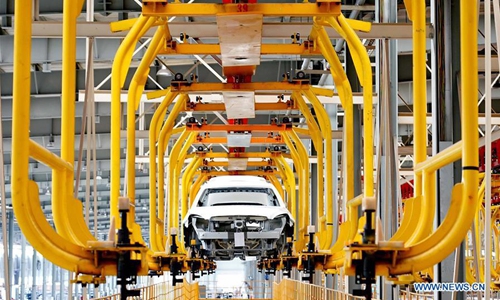China's Caixin manufacturing PMI at 52.8 in July, highest since February 2011
Source: Global Times Published: 2020/8/3 12:13:40

China's manufacturing PMI Photo: Xinhua
China's Caixin manufacturing purchasing managers index (PMI) was at 52.8 in July, higher than expectations of 51.3 and up 1.6 percentage points from June, according to data released on Monday. Manufacturing output has been in the expansion territory for five consecutive months, with the July index seeing its highest reading since February 2011.
Analysts said the PMI showed China's manufacturing sector is steadily recovering from the coronavirus outbreak. There are three reasons the manufacturing PMI beat market expectations: production resumption, improved demand and the procurement of enterprises.
The expansion trend is in line with the manufacturing PMI released by the National Bureau of Statistics, which rose to 51.1 in July, up 0.2 percentage points from the previous month. A reading above 50 indicates expansion, while a reading below 50 reflects contraction.
The PMI for small businesses fell 0.3 percentage points to 48.6 percent in July, with both the production and new orders indices below the line of expansion, indicating pressure on both supply and demand.
"Under the impact of the coronavirus epidemic and floods, micro, small and medium-sized enterprises are under increasing pressure and need support from targeted policies, which are the main force to attract employment," Tang Jianwei, chief macro analyst at the Financial Research Center of the Bank of Communications, told the Global Times.
With the comprehensive promotion of work and production resumption, production indices of most industries have entered the expansion range, said Tang.
Production indices for textile, clothing, and other manufacturing industries in July have risen above the line of expansion for the first time since the coronavirus outbreak began.
Tang added that demand continues to improve in both domestic and overseas markets.
According to Caixin, the new orders index in July recorded its highest level since February 2011, marking two consecutive months of expansion. The index for new export orders has now risen for three months in a row, although it is slightly below the line that separates expansion from contraction.
"The outbreak of COVID-19 overseas continued to weigh on exports, but manufacturing PMIs in the US and the eurozone rose to their highest levels in nearly 18 months as the pandemic situation gradually improved, contributing to an improvement in external demand expectations," said Tang, adding that enterprises have also increased their procurement efforts.
The raw materials inventory index has been in the expansion territory for two consecutive months, in July recording its highest level since March 2018.
"The PMI index is expected to remain at an expansion level in the second half of the year, but the worsening external demand environment is the biggest uncertainty. Overall, China's economy is expected to continue to improve and will remain one of the fastest-growing economies in the world, leading the global recovery from the pandemic," Tang noted.
Posted in: ECONOMY